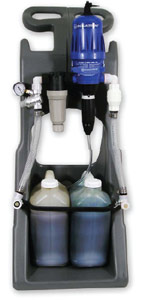
Aggressive Reduction of LDS Conditions and Soil Salts
 Finally, there is a way to easily and safely apply an aggressive treatment strategy to manage hydrophobic conditions and salt build-up in greens and tees. Introducing...The Aggressor!
Finally, there is a way to easily and safely apply an aggressive treatment strategy to manage hydrophobic conditions and salt build-up in greens and tees. Introducing...The Aggressor!
The Aggressor is the first soil treatment application strategy that applies both pHAcid Soil Water Acidifier for the reduction of soil salts and Revert Water Repellency Management Surfactant to correct water repellency conditions in greens. This unique piece of spray equipment provides a mobile spray station that can blend these two products in recommended ratios that can then be applied via hand syringing, through spray applications or injected with hydroject machines.
The Aggressor also provides enough water to create a flushing event while applying Revert and pHAcid sprayable (a key feature when treating soil salts).

